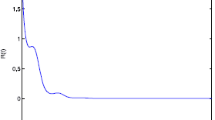Abstract
The present paper deals with a free boundary problem modeling the growth process of necrotic multi-layer tumors. We prove the existence of flat stationary solutions and determine the linearization of our model at such an equilibrium. Finally, we compute the solutions of the stationary linearized problem and comment on bifurcation.



Similar content being viewed by others
References
Byrne H, Chaplain M (1995) Growth of nonnecrotic tumors in the presence and absence of inhibitors. Math Biosci 130:151–181
Crandall MG, Rabinowitz PH (1971) Bifurcation from simple eigenvalues. J Funct Anal 8:321–340
Cui S, Escher J (2009) Well-posedness and stability of a multi-dimensional tumor growth model. Arch Rational Mech Anal 191:173–193
Escher J, Matioc A (2011) Bifurcation analysis for a free boundary problem modeling tumor growth. Arch Math 97:79–90
Escher J, Matioc A, Matioc B (2011) Analysis of a mathematical model describing necrotic tumor growth. arXiv:1005.2506v1 [math.AP]
Friedman A, Hu B (2007) Bifurcation for a free boundary problem modeling tumor growth by Stokes equation. SIAM J Math Anal 39(1):174–194
Friedman A, Hu B, Velazquez JJL (2001) A Stefan problem for a protocell model with symmetry-breaking bifurcation of analytic solutions. Interfaces Free Bound 3:143–199
Friedman A, Reitich F (1999) Analysis of a mathematical model for the growth of tumors. J Math Biol 38:262–284
Friedman A, Reitich F (2000) Symmetry-breaking bifurcation of analytic solutions to free boundary problems. Trans Amer Math Soc 353:1587–1634
Gilbarg D, Trudinger NS (1977) Elliptic partial differential equations of second order. Springer, New York
Hao W, Hauenstein J, Hu B, Liu Y, Sommese A, Zhang Y (2012) Bifurcation for a free boundary problem modeling the growth of a tumor with a necrotic core. Nonlinear Anal Real World Appl 13:694–709
Kim JB, Stein R, O’Hare MJ (2004) Three-dimensional in vitro tissue culture models for breast cancer—a review. Breast Cancer Res Treat 149:1–11
Kyle AH, Chan CTO, Minchinton AI (1999) Characterization of three-dimensional tissue cultures using electrical impedance spectroscopy. Biophys J 76:2640–2648
Müller-Klieser W (1997) Three-dimensional cell cultures: from molecular mechanisms to clinical applications. Am J Cell Physiol 273:1109–1123
Ward J, King J (1997) Mathematical modelling of avascular-tumour growth. IMA J Math Appl Med Biol 14:39–69
Zhou F, Escher J, Cui S (2008) Bifurcation for a free boundary problem with surface tension modeling the growth of multi-layer tumors. J Math Anal Appl 337:443–457
Acknowledgments
The author thanks the anonymous referee for asking about the bifurcation problem associated with the model of the paper at hand which led to an additional chapter compared to the initially submitted version.
Author information
Authors and Affiliations
Corresponding author
Rights and permissions
About this article
Cite this article
Kohlmann, M. Necrotic Tumor Growth: An Analytic Approach. Acta Biotheor 60, 273–287 (2012). https://doi.org/10.1007/s10441-012-9159-z
Received:
Accepted:
Published:
Issue Date:
DOI: https://doi.org/10.1007/s10441-012-9159-z



